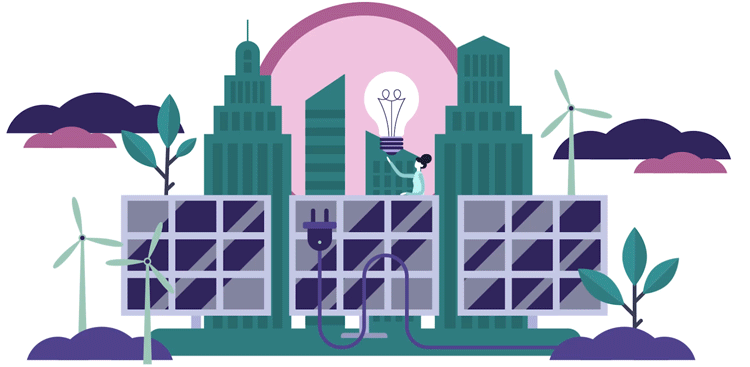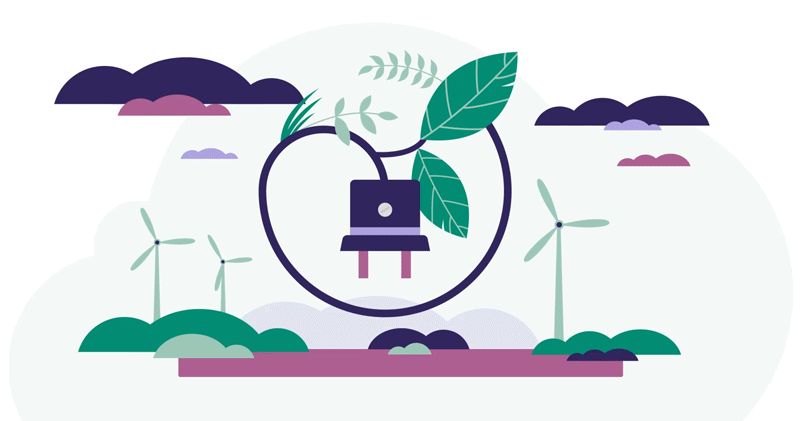THE C-SUITE & SUSTAINABILITY:
A Symbiotic Relationship
for a Green Future
• Brought to you by employee experience thought-leaders

We’re living in a pivotal era. The human-influenced climate crisis is causing the Earth’s climate to change in unprecedented ways, with extreme weather events now more common than ever. In August 2021, the Intergovernmental Panel on Climate Change released its first report since 2013 and it made damning conclusions. It pointed out that through its actions – or lack thereof – humanity has caused severe heating of the planet and rising temperatures, extreme flooding, deadly wildfires and droughts experienced everywhere on Earth has been the result.
Although the outlook may be gloomy, we’re not without hope. If action is taken now, we can limit the worst effects of the climate crisis. A renewed commitment to sustainability is the only way forward. Whilst governments can and should champion sustainable policies, time is of the essence – it’s vital that private companies also commit to sustainable practices now.
In this exclusive report, CEO.digital teamed up with Citrix to find out more about where the private sector should turn its attention to when accelerating sustainability initiatives. We spoke to a range of thought leaders working within companies like Capgemini, Ericsson, BCG, LVMH, and more to shine a light on this topic. Across production, supply chains, IT, working practices and culture, this is where the climate action begins.

CHAPTER 1
Is Your Supply Chain Sustainable?
First and foremost, it’s important to remember that when it comes to the climate crisis it’s fundamentally an issue of consumption and wastage. To produce the world’s goods and services, a vast amount of energy and raw materials are being consumed at an unsustainable rate and not replaced. The consumption and wastage combined is both causing and accelerating climate change. Therefore, it’s wise to start looking at both the means of production and the whole supply chain when thinking about sustainability.
In our conversation with Dr Marcell Vollmer (Boston Consulting Group – BCG), he highlighted the potential of emerging technologies to change the way that supply chains operate for a greener future. One of the most obvious areas of focus was the fact that current ‘just-in-time’ supply chains often saw products move across borders with ease and, from a climate perspective, without logic. Taking one example, Vollmer showed that a product may make multiple journeys to and from countries on either side of the world’s largest ocean, the Pacific – the carbon impact of which was immense. But from a profitability perspective, this has made sense in the past. As Brexit also showcased, ‘just-in-time’ production could see the production of small but vital components to automobiles shifting across the entire continent before finally being installed in the vehicle at a manufacturing plant in Northern England. As a result, the carbon footprint of a car is already astronomical even before the new machine itself starts consuming fuel and producing emissions.
Emerging technologies, however, are opening up new opportunities for companies. Intelligence and enhanced data analytics potential is helping to identify chances to limit carbon emissions in the supply chain. What were once small gains, such as identifying where and when products will be needed most so as to limit unnecessary fuel expenditure, are growing in scale and ambition. Now, questions about whether products can be produced closer to the markets in which they’re sold are being asked once again – and it’s the transparency that data provides that’s helping the C-suite to make the right decisions.
Transparency is the keyword here. In the past, it was easier for suppliers to dupe global companies about their production practices – assuming companies cared enough to look. But with technologies like blockchain, the distributed ledger technology behind cryptocurrencies, companies can reduce risk and fraud in a scalable manner by making the records of any digital asset transparent and unchangeable without involving any third-party intermediary. It’s now becoming easier for companies to monitor the way their products and services are produced.
How Can We Greenify Production?
Jodi Muter-Hamilton, Founder of Other day and sustainability thought leader, has been working to make fashion greener for over a decade, specifically working with fashion tech start-ups to connect more meaningfully with their audiences. And there’s perhaps no more pertinent topic right now to connect with audiences than sustainability.
It doesn’t take much to see that fast fashion is highly unsustainable. Products aren’t created to last, and they’re manufactured cheaply thousands of miles from where they’re eventually sold, using up raw materials from the Global South and causing immense emissions on their journey to the end consumer. More environmentally minded companies are looking at how to improve the sustainability of their products with technology. Muter-Hamilton points out that technology can be used to identify each step of the production lifecycle, monitoring it and providing a wealth of data that can be used to formulate the product’s carbon footprint. Where can carbon savings be made? Where could recycled materials be used instead of raw materials?
These are the kinds of things that forward-thinking companies must now consider. As Dr Vollmer (BCG) argues, soon it will be investors making these kinds of decisions for companies. They will only invest in companies with sustainability embedded into their core. And customers will follow suit. Sustainability, after all, isn’t just a good idea for the planet; it’s just good business, too. “If consumers request and demand what the sustainability footprint is on the product, you need to provide that. It could be easy for consumers to walk away if they want to focus on something that has more positive impacts on the environment. You need data to understand that,” Dr Vollmer said.
In a recent episode of our podcast, The CEO.digital Show, we were lucky enough to interview the COO and CFO of Moët Hennessy Louis Vuitton (LVMH), Mark Stead. During our conversation, Stead talked about how LVMH is now looking to more sustainable agriculture processes. Focus here has been on ensuring that there are enough pollinators for the crops, but also on maintaining the soil and land so that future generations can also utilise it for production in an environmentally friendly way. “When you do that, you’re reducing yields because you’re using up some of the land to plant biodiversity,” said Stead. “But first, even though that might have a bit of a negative short-term effect, we think we’re better off in the long term because our children will inherit better quality land.”
From a company perspective, this means that LVMH can transform for a new era – which is the biggest challenge for heritage and luxury brands at the moment. Traditionally, these brands have found it difficult to move into the digital age, but now a renewed focus on sustainability is causing a rethink. “Consumers want to have that [digital] relationship with us, so we’re working quite hard on bringing to life luxury digital experiences online in a way that we can control the experience right to their house.” Transformation is no longer a nice-to-have; it’s an absolute necessity.


About The CEO.digital Show
The CEO.digital Show is CEO.digital’s peer-to-peer podcast series where we talk to the most influential thought leaders about how tech is continuing to change the way the world does business.
Each episode, we interview major thought and industry leaders to learn how they are embracing new technologies and strategies to create new value and success for their companies.
Find us on all major podcast streaming platforms.

If consumers request and demand what the sustainability footprint is on the product, you need to provide that. It could be easy for consumers to walk away if they want to focus on something that has more positive impacts on the environment. You need data to understand that.
Dr Marcell Vollmer
Partner and Director, BCG

CHAPTER 1
CHAPTER 3
CHAPTER 2
What Role Does IT Have to Play on Sustainability?
It’s no secret that the cloud has transformed the way companies operate and, in the past year, what we think the modern workplace can and should be. Remote working wouldn’t have been possible without the long and sustained investments in cloud technology that companies have been making for several years now. But how exactly is IT helping the enterprise to be more sustainable?
We spoke with Dr Ahmad Karnama, Director of Sustainability at Ericsson and Executive Chairman of Ween Energy AB, about the specific role technology is playing on the sustainability of business. He turned our attention to data centres. Anyone that works in anything remotely digital will be able to tell you that the sheer volume of data the world is producing is increasing exponentially. What they may not discuss is where that data is being stored.
Data centres are taking up ever more real estate and consuming more energy as they do so. For now, most of that energy is produced by burning fossil fuels. It can be easy to forget, but although data is digital it has a real-world effect on emissions. For Karnama, that means we must ensure our data centres are powered by renewable energy, sooner rather than later.
However, it isn’t just up to the data centre providers to facilitate this. IT leaders can vote with their investments, making ethical and green decisions about which provider to use for their cloud requirements. Otherwise, the use of a non-sustainable data centre must surely increase the enterprise’s carbon footprint.
When talking to Dr James Robey of Capgemini, we learned that if you were to liken the world’s entire tech sector as a country, it would be the third-largest energy consumer in the world. The carbon impact of our industry is therefore astronomical – we need new ways of thinking about how we power our enterprises, and we need them now.
A New Way of Thinking About Energy Consumption
Dr Karnama (Ericsson & Ween Energy AB) also noted that we could be doing more to harness the by-products of our data centre usage, specifically heat. Recently, Dr Karnama released a paper detailing how data centres in Scandinavia could harness the heat produced by the data centre (servers, clearly, produce a lot of excess heat) and channel it through into a greenhouse situated next to the data centre to use in agricultural production throughout the year.
Similarly, Dr Karnama has focused his academic attention on electric vehicles. Transportation is another major source of emissions and greenhouse gases, and so his efforts have been spent on trying to find a way to empower people to travel with less impact on the environment. For Dr Karnama, the technology is now there, but the political will to make something happen soon may not be.
Interestingly, Dr Karnama believes we may be seeing this kind of will from private enterprises more than from some governments. In the past, the main challenge as a leader of sustainability was getting enough attention and buy-in for projects. Now, however, the challenge is managing the influx of attention and directing it to where it’s useful. More people than ever understand the dangers climate change poses and want to do something about it. The trick for sustainability leaders is to take that energy and channel it into a cohesive strategy for greenifying the company and having a positive impact on the environment. There is a risk of ‘too many cooks spoil the broth’ here, but never has there been so much potential for change. And that change, Dr Karnama shows, should be good for both business and environment.
One way that businesses could adapt and channel new interest in sustainability is by maintaining the flexible working practices and focus on digital workspaces that arose following the outbreak of the coronavirus global pandemic…

When you do that, you’re reducing yields because you’re using up some of the land to plant biodiversity. But first, even though that might have a bit of a negative short-term effect, we think we’re better off in the long term because our children will inherit better quality land.
Mark Stead
CFO, LVMH


Want to Find Out More on Employee Experience?
Workplaces are changing in the face of global challenges like Covid-19. Targeted at C-level HR and IT professionals alike, Citrix’s new series of thought leadership and networking events on shows how IT and HR are the pillars for employee experience.
CHAPTER 1
CHAPTER 3
CHAPTER 3
How We Work Must Evolve
As sustainability races to the top of the agenda for many governments and companies alike, it’s clear that the way we work will have to change.
Fortunately, we have the technology and many companies have already had to change their behaviour in a way that promotes sustainability: flexible and remote working. Transport accounts for around one-fifth of global carbon dioxide emissions, and commuting to and from work constitutes a major portion of transportation usage throughout the world. If the workforce can work from home, therefore, they would be helping to cut emissions on a daily basis.
The question here is, would this have a detrimental impact on the ability of companies to not only do their primary work, but to innovate and excel too? Technological solutions like Citrix’s digital workspace help to bring the workforce together on projects no matter where they’re working – remotely, in the office, or both.
In a recent Citrix study, it was also found that “by reducing commuting hours and consolidating real estate through sustainable IT practices, remote work could help reduce annual carbon dioxide emissions by 214 million tons.” Digital workspaces are just one possibility here. Other IT solutions could include automating processes to reduce energy consumption, finding ways to enhance productivity through more scalable solutions, and making wise investments in IT assets to extend the lifecycle.
There is clearly potential for changing working practices to benefit sustainability efforts. As a result, we should also expect regulations to evolve to reflect that. But as is the case now, those regulations will differ between countries and territories. Some will be more sustainable than others.
For Dr Vollmer (BCG), this means companies will have to work dynamically to get their operations in line and up to speed. If a company operates in more than one country, for instance, there may be different working practices required in each to remain compliant. But, as some regulations will be more stringent than others, it would make most sense to work towards the highest regulatory ceiling and therefore cover your practices regardless of country.
Microsoft is one company that’s getting ahead of the curb. In 2020, the company set itself the ambitious goal of becoming carbon negative by 2030. Its first year has been a resounding success. Microsoft managed to reduce its carbon emissions by 6% in its first year since setting its goal, dropping from 11.6 million tons to 10.9 million metric tons of carbon emitted. Furthermore, Microsoft paid for the removal of 1.3 million tons of carbon from the atmosphere. The main strategic changes have been investments in electric vehicles, battery systems and renewable power, but also an internal carbon tax on emissions created by its suppliers and customer product use.
Changing the Mentality of Business
Jodi Muter-Hamilton (Other day) raises the problem that traditional business thinking is the antithesis of sustainability. Capitalist businesses have been founded on the idea of growth, and that’s meant consumption has increased at an unsustainable level. Muter-Hamilton shows that, actually, businesses must build their models to scale, not simply growth for growth’s sake. “I feel it’s the producer’s responsibility to take control of the sustainability conversation rather than leave it to the consumer,” Muter-Hamilton said.
Dr Karnama (Ericsson & Ween Energy AB) agreed. He argues that sustainability should be integrated into the entire corporate strategy, not just as a cost or risk element but as a new area in which businesses can thrive in the long-term.
But changing the very mentality of modern business will require a complete culture shift within the enterprise.

The UN’s Sustainable Development Goals
In 2015, the United Nation’s adopted a selection of 17 Sustainable Development Goals to help end poverty, protect the planet, and promote peace and prosperity.
When looking at your own sustainability initiatives, it would be wise to look at these goals to help do your part. The goals are all integrated, so efforts in one area will impact others. But key ones to look out for are:
-
- Sustainable Cities & Communities
- Industry, Innovation & Infrastructure
- Decent Work & Economic Growth
- Affordable & Clean Energy
- Responsible Consumption & Production
- Climate Action

I feel it’s the producer’s responsibility to take control of the sustainability conversation rather than leave it to the consumer.
Jodi Muter-Hamilton
Founder, Other day

CHAPTER 1
CHAPTER 3
CHAPTER 4
Building a Sustainability-First Culture within the Enterprise
So far, we’ve discussed some key practices and areas to focus on when it comes to sustainability, but while taking action is of the utmost importance, there needs to be the will within the company culture to take said action in the first place.
As a result, corporate culture will be where the fight for sustainability will be lost or won within the private sector. For Dr James Robey, Global Head of Sustainability at Capgemini, success will depend on greener practices being implemented from the top down. “Ultimately, sustainability has to be driven from the top,” he said. “The CEO has to take a personal responsibility for setting the agenda. In terms of a practical perspective, it’s about having the right sponsorship. It’s about having the right people in your governance team.” People should be encouraged to adopt more sustainable practices, and this should be a cultural dynamic throughout the company.
But more importantly, it will be up to the CEO to take on a greater responsibility when it comes to sustainability. The reason for this, according to Robey, is simple: sustainability doesn’t just sit within one element of the corporation. It cuts across departments, with each function having an impact on the overall sustainability progress of the company, and decisions made within one function having a direct impact on other functions.
For instance, Robey highlights the case of IT departments shifting to more sustainable practices. While this may initially cause some degree of cost incurred by the department as investments in green technologies and/or practices are made, cost savings could subsequently occur in other departments like real estate as energy costs fall. Robey says that it will be up to the CEO to cut across departments and make these calls that help the business as a whole. Ultimately, individuals like the CEO will be the only ones who can make those kinds of calls because they have a business-wide perspective – and sustainability requires business-wide solutions.
While we can’t wait for younger generations to come through into more senior positions and bring sustainable thinking with them, it is nonetheless reassuring that younger thought leaders are consciously thinking about and acting to bring about a green revolution.
Vattenfall is one of Europe’s largest producers and retailers of electricity and heat, but it has long been committed to a fossil-free future with a vision to power smarter living within a single generation. One of its most inspiring projects is the Vattenfall Solar Team, a collaborative effort from 17 students from the Delft University of Technology. The team, utilising Citrix’s sustainable IT and products solutions, aims to build a fully solar-powered vehicle to compete in a one-of-a-kind solar race through the Moroccan desert this year to showcase the possibilities of solar technology and how we can all use it and innovative thinking to build a sustainable future.
The scale of ambition coming from generations like that in the Vattenfall Solar Team showcases that there’s much to be hopeful about in the future. But likewise, they demonstrate that the means through which we’ll help limit the effects of climate change and help save the planet are already here. We have the technology. What we need now is the will to use it.


Ultimately, sustainability has to be driven from the top. The CEO has to take a personal responsibility for setting the agenda. In terms of a practical perspective, it’s about having the right sponsorship. It’s about having the right people in your governance team.
Dr James Robey
Global Head of Sustainability, Capgemini

CHAPTER 1
CHAPTER 3
There Is Hope for a Sustainable Future
Speaking after the release of the IPCC’s report in August 2021, Kristina Dahl of the Union of Concerned Scientists argued the “continued dithering to address climate change is no longer about the lack of scientific evidence, but directly tied to a lack of political will.” While Dahl may have been speaking primarily of governmental leaders, the statement also applies to the private sector.
While just 100 companies are responsible for 71% of global greenhouse gas emissions, every company contributes in some way – it is everyone’s responsibility to change for the better. From the technology and asset side of things such as sustainable office design features, considering the environmental impact when procuring of IT assets, and sourcing responsibly, to the people and community aspect of encouraging a more sustainable culture and attitude.
It’s time to revolutionise the way we operate to save the planet and the future. And the ideas laid out in this report are a good place to start.
• Brought to you in collaboration with
Citrix provides technology that empowers organisations to unlock potential and deliver a better employee experience. Citrix’s goal is to give people the space to succeed and do their best work – wherever they are.
The Citrix platform brings intelligence, virtualisation, workspace and app delivery, a zero-trust security approach, and data analytics together in a seamless experience that fosters innovation, resilience, and business continuity. From enabling sustainable remote work models to streamlining the journey to multi-cloud, Citrix helps securely deliver how work gets done today and in the future.
For articles, reports, podcasts and events on workplace experience and sustainability, visit the Citrix portal.

